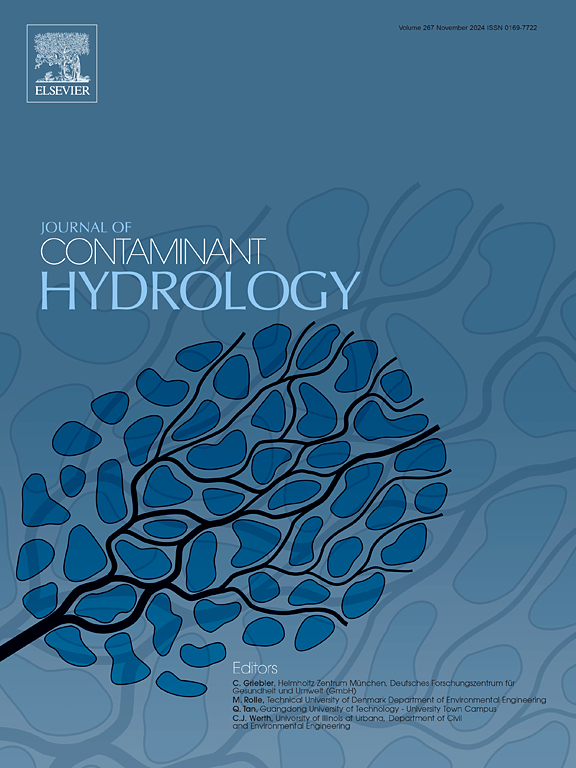大肠杆菌在两种酸性土壤中的迁移:微生物诱导方解石沉淀技术的影响。
IF 3.5
3区 环境科学与生态学
Q2 ENVIRONMENTAL SCIENCES
引用次数: 0
摘要
微生物诱导的方解石沉淀(MICP)在中和土壤pH值的同时,可能导致孔隙堵塞,从而减少细菌的运输。本研究旨在评价MICP工艺对两种酸性土壤中大肠杆菌的过滤效果。从Amlash (Am)和Lahijan (La)地区收集pH值分别为5.88和3.93的2个土壤样品,倒入14.92 × 2.4 cm的塑料柱中。对于MICP反应,土壤柱用固化溶液(1:1尿素:CaCl2, 1.5 M)和巴氏孢子孢杆菌(~ 108细胞mL-1)饱和,并在30°C下孵育72 h。在稳态饱和流动条件下,对MICP处理和对照土壤柱进行浸出实验。在土壤柱顶部加入含有大肠杆菌(耐环丙沙星)(~ 108细胞mL-1)和溴示踪剂(1000 mg L-1 KBr)的进水脉冲(0.1 PV),然后加入无菌水收集流出物。测定了回收的大肠杆菌和渗滤液中的Br-、HCO3-、NH4+、Ca2+离子。此外,还对土壤中残留的大肠杆菌数量、脲酶活性和生物沉淀CaCO3含量进行了评估。与生物沉淀CaCO3相关的是,在Am和La土壤中,MICP处理后的水力传导系数(Ks)分别降低了4.4倍和5.8倍,从而显著降低了细菌淋溶。在La土柱中,大肠杆菌的过滤系数(λf)和回收率较高,可能是由于较低的pH和较高的阴离子交换容量分别导致较高的细菌死亡率和静电吸引力。与对照柱相比,MICP处理使大肠杆菌的平均和累积计数减少了约3.4倍。综上所述,在酸性土壤中施用MICP提高了土壤pH值,并通过降低土壤导电性降低了大肠杆菌向深层迁移的风险。本文章由计算机程序翻译,如有差异,请以英文原文为准。
Escherichia coli transport in two acidic soils: Effect of microbially induced calcite precipitation technology
Microbially induced calcite precipitation (MICP) while neutralizing soil pH, can lead to pore clogging which in turn may reduce bacteria transport. This study aimed to evaluate the effectiveness of the MICP process for E. coli filtration in two acidic soils. Two soil samples from Amlash (Am) and Lahijan (La) areas with pH values of 5.88 and 3.93, repectively, were collected and poured into plastic columns (14.92 × 2.4 cm). For the MICP reaction, the soil columns were saturated with a solidification solution (1:1 urea: CaCl2, 1.5 M) and Sporosarcina pasteurii (∼108 cell mL−1), and incubated at 30 °C for 72 h. Leaching experiments were conducted on both MICP-treated and control soil columns at steady-state, saturated flow condition. A pulse of influent (0.1 PV) containing Escherichia coli (ciprofloxacin-resistant) (∼108 cell mL−1) and bromide tracer (1000 mg L−1 KBr) was added at the top of the soil columns, followed by sterile water to collect the effluent. Recovered E. coli, and Br−, HCO3−, NH4+, Ca2+ ions were measured in the leachate. The profile of residual E. coli count, urease activity, and bioprecipitated CaCO3 content were also assessed in the soil. Correlated with bioprecipitated CaCO3, the hydraulic conductivity coefficients (Ks) was reduced by 4.4 and 5.8 times after MICP treatment in Am and La soils, respectively, thus bacteria leaching was significantly reduced. A higher filtration coefficient (λf) and recovery rate of E. coli were calculated in the La soil column, likely due to the lower pH and higher anion exchange capacity, which induced greater bacterial mortality and electrostatic attraction, respectively. MICP treatment reduced the average and cumulative count of E. coli by ∼3.4 times compared to the control column. In conclusion, the application of MICP in acidic soil increased soil pH and reduced the risk of E. coli transport to deeper layers by reducing soil hydraulic conductivity.
求助全文
通过发布文献求助,成功后即可免费获取论文全文。
去求助
来源期刊

Journal of contaminant hydrology
环境科学-地球科学综合
CiteScore
6.80
自引率
2.80%
发文量
129
审稿时长
68 days
期刊介绍:
The Journal of Contaminant Hydrology is an international journal publishing scientific articles pertaining to the contamination of subsurface water resources. Emphasis is placed on investigations of the physical, chemical, and biological processes influencing the behavior and fate of organic and inorganic contaminants in the unsaturated (vadose) and saturated (groundwater) zones, as well as at groundwater-surface water interfaces. The ecological impacts of contaminants transported both from and to aquifers are of interest. Articles on contamination of surface water only, without a link to groundwater, are out of the scope. Broad latitude is allowed in identifying contaminants of interest, and include legacy and emerging pollutants, nutrients, nanoparticles, pathogenic microorganisms (e.g., bacteria, viruses, protozoa), microplastics, and various constituents associated with energy production (e.g., methane, carbon dioxide, hydrogen sulfide).
The journal''s scope embraces a wide range of topics including: experimental investigations of contaminant sorption, diffusion, transformation, volatilization and transport in the surface and subsurface; characterization of soil and aquifer properties only as they influence contaminant behavior; development and testing of mathematical models of contaminant behaviour; innovative techniques for restoration of contaminated sites; development of new tools or techniques for monitoring the extent of soil and groundwater contamination; transformation of contaminants in the hyporheic zone; effects of contaminants traversing the hyporheic zone on surface water and groundwater ecosystems; subsurface carbon sequestration and/or turnover; and migration of fluids associated with energy production into groundwater.
 求助内容:
求助内容: 应助结果提醒方式:
应助结果提醒方式:


